Editor’s Note by Noah: Attack on Titan is currently being serialized in English, by Kodansha USA. You can purchase it from Amazon here
_____
I’m starting to feel alone in my disappointment with Pacific Rim. I mean, I know the critics agree with me – even the ones who liked the movie admit it lacks psychological complexity, is full of one-dimensional stock characters, and often drags. But somehow gentle criticism doesn’t seem like enough when Pacific Rim is – really – the best example yet of why screenwriters shouldn’t force every blockbuster into the Save the Cat! mold.
I mean, my friends liked – no, loved – this movie. They loved the Kaiju designs, cast, and art direction. They’ll defend the movie against people who point out that there didn’t need to be four – count ’em, four – “plot twists” or reversals, mostly all predictable. (The first twist is the exception – that one was surprising and quite moving.) Or that there didn’t need to be a 15-minute narrated prologue that boiled down to “monsters appeared so we built giant robots to fight them, P.S. I am your obligatory knucklehead fly-boy protagonist”. Or that between the big set pieces, the movie was mostly one long planning or training sequence.
They’ll even defend the fact that nearly every character is a walking cliche. Or, if they are less passionate in their opinions, they’ll say what everyone says: that it’s just a mindless summer blockbuster, so really, what were you expecting? Don’t you know that all of these big-budget action movies are being made for an overseas audience, anyway?
So maybe my problem with Pacific Rim isn’t that the movie was awful, but that I went into it with the wrong mindset – because truthfully I was expecting something much, much better.
Described to me as “Guillermo del Toro makes a live-action Evangelion“, I was expecting a very different movie: not Evangelion, obviously, but something with at least a little bit of the psychological depth and roller-coaster pacing of that anime. Instead I found a movie built for defense, not suspense: it’s armor-coated against anyone’s possible complaint that it didn’t hit the right note at the right time. (Headstrong protagonist check, strong female love interest check, stern commanding officer check, eccentric scientist double-check, minorities in non-speaking roles, check).
Some plot points are similar to Evangelion’s – the monsters that suddenly appear from a portal over Antarctica/the Arctic, the shadowy global organization that requires pilots to mind-meld in giant robots to fight them, the pilot-pilot romance – but those are pretty superficial similarities, really. Pacific Rim is a very different, and far less cynical, beast – which is fair enough, considering that Guillermo del Toro’s most popular movies have generally been made for children.
Anyway, I was wrong to expect classic cult-hit anime Evangelion. What I should have expected was current cult-hit anime Attack on Titan.
So let’s not talk about Pacific Rim. It’s a monster movie made for an international audience; it hits all the right notes; it looks great. There are even one or two genuinely moving scenes. It’s kid-friendly and has positive, uplifting messages about humanity. (In short, it’s boring.) Let’s not even talk about Evangelion, since Pacific Rim has very little in common with that anime.
Instead, let’s talk about Hajime Isayama’s Attack on Titan.
In the world of Attack on Titan, humanity has retreated behind three colossal walls. (In Pacific Rim, there is a plan to build a colossal wall, but it fails right away.) The wealthy and politically powerful live in the innermost ring, where they barely worry about being attacked by human-eating monsters. The hard done-by live in cities projecting from the wall of the outermost ring, where their main purpose is to attract Titans. It’s not economical to defend the whole wall, you see, so concentrating people as bait in small areas reduces the area that needs to be defended.
From the set-up alone, you can feel the cynicism, right? Attack on Titan is a fairly cynical – or you could say realistic about the failings of large-scale social structures – series. Pacific Rim supports the well-worn, slightly unfashionable trope of humanity banding together when faced with a common threat; Attack on Titan, on the other hand, interrogates it:
The source of horror is different, too: more threatening, more personal, and harder to fight. In Pacific Rim, the monsters are absolutely victorious for a short time… but only before the movie starts, and only offscreen. For 90% of Pacific Rim’s running time, barring one or two on-screen causalities, humanity is containing the threat.
In Attack on Titan, however, just when it seems that people finally have the upper hand, the monsters evolve intelligence – or armor – or kung-fu – or even more monstrous size, and whatever advantage humanity might have had is taken away. And then it’s back to being chased, trapped, overcome, and eaten, by horrible monsters that are impossibly bigger and stronger than you.
The Titans… why do they exist? Why do they eat people? Why are they sometimes only 9 feet tall, and sometimes over 50 feet tall? Why are some unclothed and some armored? Why are some mindless and some intelligent? Why do some behavior predictably and others unpredictably?
It’s all a mystery. Each time humanity makes some progress toward understanding the Titans, the Titans become that much more horrible and unstoppable in response. The logic here is the logic of nightmares – that you can’t escape, that you’ll always be devoured in the end. It is the horror-movie logic of absolute powerlessness.
The mysteriousness of the Titans is a big part of what makes them horrible. That’s because once you know what something is – once you know how it can be defeated – you have already taken the first step on the path from powerless victim to crafty survivor. Knowledge is the difference between an existentialist horror movie like The Grudge – where the only way to win against the haunted house is to not enter it in the first place – and a survivalist horror movie like the American remake of The Grudge. There are moments of hope in Attack on Titan, but the overall tone is bleak: when the monsters outnumber the humans and are practically impossible to kill, what can be done?
The Kaiju attacks in Pacific Rim are quite different – they only appear to be random, but are in fact highly regular, to the point that they can be predicted mathematically. As explained by Eccentric Scientist#2, the kaiju appear first in an uninhabited place and then head for major population centers, where they primarily damage infrastructure. At first they appear singly, with long gaps in between, allowing humanity plenty of time to regroup. As the movie progresses, they show up more frequently. The fights between the monsters and the robots are destructive – we see Hong Kong basically leveled – but due to this attack pattern they are also clean, with minimal casualties.
In Attack on Titan, the action is smaller-scale and messier. The monsters look like us – like nude people, but bigger and uglier, with sharper teeth. Regular humanity doesn’t have giant robots, or even tanks or guns: only canons, swords, “gas packs” and climbing hooks. The fights are up close and personal… and so are the losses.
You see, the Titans have no interest in property damage. They exist only to eat people. They don’t need to eat people – they don’t have stomachs, are hollow inside.
So why do they eat people? Because eating people is horrible.
But don’t get me wrong: Attack on Titan isn’t purely a horror series. At first it seems that way: in a prologue from the point of view of the three main characters as children, the Titans can’t be resisted, and so everyone who doesn’t escape from them is eaten. Once the main characters grow up and join the army, however, the tone changes. We find out that the military Scouts – who seemed incompetent from the outside – actually do know a thing or two about fighting Titans. In fact, they know quite a lot! Occasionally they are even able, with the skills and knowledge they have painstakingly acquired, to temporarily win against the Titans.
The protagonists constantly learn and adapt, but it’s never enough. The manga is a push and pull between gaining power to venture out into the unknown; and finding out that the world is more even more unpredictably cruel than you had imagined. That kind of push-pull, between power and powerlessness, is similar to Jojo’s Bizarre Adventure, and indeed you can see a kind of homage in one sequence involving an intelligent, sadistic giant monkey.
Jojo fans who’ve read Part 3: Stardust Crusaders will know what I’m talking about here.
In the world of Attack on Titan, people are sometimes good, but just as often they are weak or venal. Additionally – and this can’t be said enough – the world is a cruel place. However, the cruelty of the world is no reason to stop fighting – if anything, it’s a reason to keep fighting:
And yet, within this cruel world, people do their jobs quite well. Even more than Pacific Rim, with its ex-marine protagonist, Attack on Titan is oriented toward military values. The chain of command should be followed at all times; commanders are competent most of the time; to die for no reason is ignoble but death in service of the greater good is honorable; in order to make sure that death is not pointless, further deaths are required.
It seems obvious to me that this set-up – although it leans further toward the Abandon Hope All Ye Who Enter Here end of the horror-movie spectrum, and although it is far more pro-military than anything del Toro has ever made – would appeal to the guy who made Pan’s Labyrinth: fundamentally it’s a story of overcoming childhood trauma, and banding together to defeat nightmarish monsters who are almost, but not quite, human.
Because adult humans who are bigger and stronger than you are fucking scary when you’re a child, am I right?
It’s also clear why del Toro, with some very popular children’s movies to his name, would want to tell a more optimistic and less depressing version of this story about transcending abuse.
And while this might be a stretch, honestly the two series seem to have enough specific similarities that I’d bank on Attack on Titan being one of the properties that went into del Toro’s Japanese-monster-movie stew. It’s not even much of a secret, really: when the main character of Attack on Titan is Eren JAEGER and the robots that fight monsters in Pacific Rim are JAEGERS, surely we can acknowledge the possibility of a connection?
And that’s just to start with. This scene might be a bit familiar to anyone who’s seen Pacific Rim:
In Pacific Rim, Mako is a Strong Female Character: the only one to best the main character in a physical fight. She’s also the only Asian character with a speaking role, in a movie that owes an obvious and explicit debt to Japanese anime and monster movies.
One could argue that she is interesting because of her hand-to-hand combat skills; because her backstory is the best and most moving scene in the movie; because the actress who plays her is charismatic; because she occupies both the Strong Female Character role and the Properly Respectful Japanese Person role, as if to say that one can uphold the cultural role expected of one and yet still be a strong person at the same time.
In Attack on Titan, the equivalent character is Mikasa. She is not just the only “Oriental” in the script, but in the whole world:
Given that both properties have an “the Asian bad-ass fighter chick” character, and given that I’m writing an article arguing for the superiority of Attack on Titan, and I don’t want to make it solely about the fact that I prefer thornier, more cynical and scarier stories, let’s talk about the treatment of female characters in each. Pacific Rim doesn’t only suffer from having a single female character with speaking lines; it suffers from the role that character plays in the story. Mako is attached to the commander of the Jaeger program because he saved her as a child; so is Mikasa is attached to Eren Jaeger. Looking similar so far – but why must Mako “belong” either to one man or another? Can’t she leave the protective custody of the father-figure without entering the protective custody of the suitor? Must women be passed from one man to another?
This isn’t a problem in Attack on Titan, not because Matsuko isn’t devoted to Eren – she is, pathologically so – but because there’s a diverse cast of female characters who are not all like her. In fact, the eccentric scientist who is a little too into the monsters is a woman – and not only a woman, but a female commanding officer!
The diverse cast of women belong to themselves, not to fathers or lovers. They’re explicitly on the same level as the male cast, fighters in the same unit of the army. The whole cast, male and female alike, share a comradely bond.
Speaking of comradely bonds, at first I thought that this series – humanity confined behind walls, lacking any way to proactively engage the enemy – might be a metaphor for a non-militarized Japan. It is, definitely, very pro-military, very pro-intervention, and very pro-violence. There are other hints of conservative thought, as well, starting from the author’s fundamentally mistrustful view of human nature.
Even disregarding the difference in worldview between Pacific Rim and Attack on Titan, though – because there are perfectly good reasons to prefer more a more optimistic narrative – Attack on Titan is the more thoughtful series, as well as the one that offers a more powerful social critique, despite being set in a stacked-deck fantasy world. The author of Attack on Titan is interested – not only in the mechanics of the fight or how the protagonists resolve their personal differences and come together to face an alien enemy – but also in the structure of the world. How do ordinary citizens feel about their taxes going towards a (seemingly useless) military? What is the incentive structure of the military, and how does it cause the best and brightest to avoid posts where they would do the most good? Is it always necessary for the minority to adapt to the needs of the majority? How does one bring about the social change one wishes to see in the world?
Of course, the series has flaws. It’s by no means trope-free, for one thing: from the dumb/suicidal shonen hero who is totally average except for his determination (to murder Titans); to the strong, silent warrior character who ensures that the main character can uphold his ideals; to the physically weak character who is nevertheless a genius strategist; there are plenty of stock characters here, too. Attack on Titan as well as Pacific Rim takes advantage of the hero’s fundamental vanilla-ness to give more spotlight to generally sidelined – but more competent! – supporting characters, which is a good and worthwhile trend I support (see also: Teen Wolf Season One), but why not take that extra step and remove the bland main character entirely?
So it’s not all gravy. And in some ways, the comparison is apples (Hollywood summer blockbuster) to oranges (Japanese manga and anime). But I’ll say it again: Attack on Titan is the stronger work.
Am I just a cynic? Do I prefer Attack on Titan because it is “darker” and (therefore) more “realistic” (as if there is anything realistic about giant monsters who eat people)? Or do I prefer it because it is, in my view, more complex, both in its characters and in the social structures they inhabit?
Maybe. I might be alone – at least among my friends – in my almost total disappointment with Pacific Rim. When even the positive reviews come with caveats that you shouldn’t “think too hard”, that you should “just enjoy the movie”, that monster movies “all about explosions”, that only “snobs” expect engaging characters alongside engaging fight scenes, however… it’s a sign that there is something amiss. I’ll stick with Attack on Titan, downer worldview, flaws, and all: at least it’s obviously the product of one person’s idiosyncratic worldview.
There’s something to be said for that downer worldview, anyway: when your protagonists are losing the battle at least half the time, their occasionally victories feel that much more earned, and sweeter.
_____
Again, Attack on Titan is available here
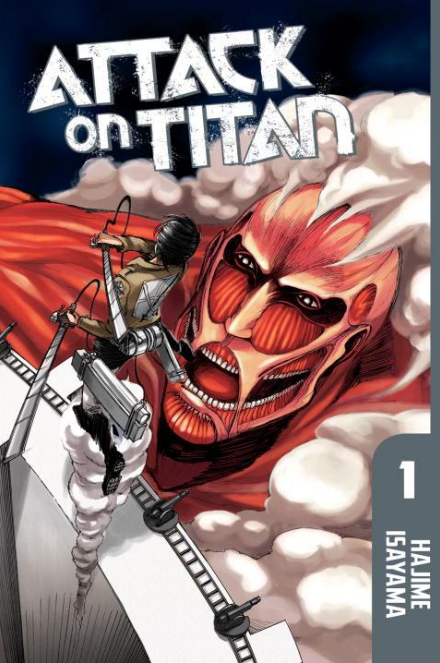
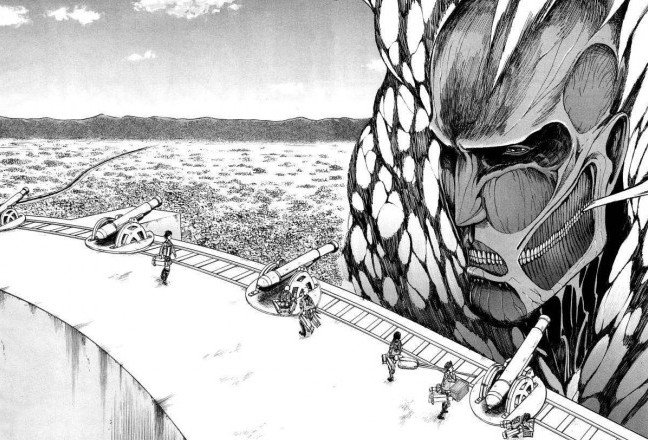
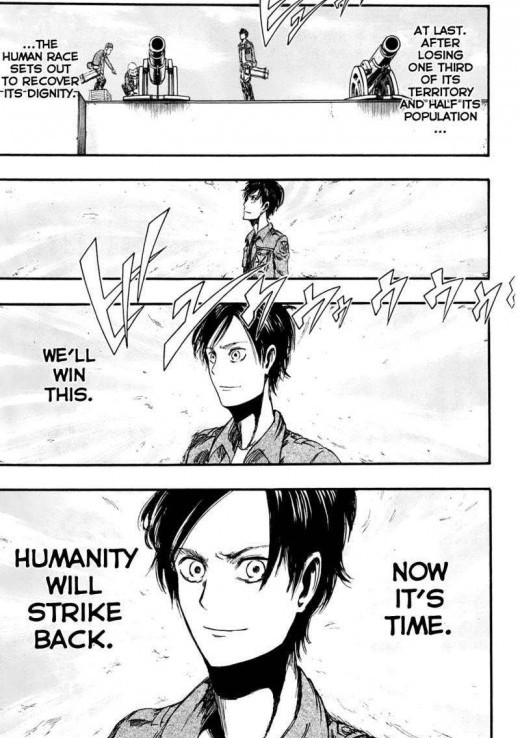
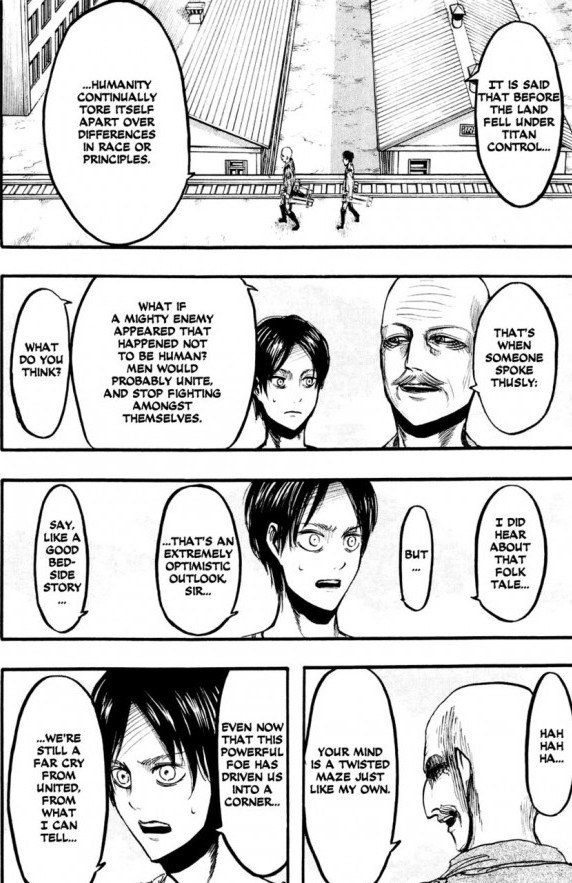
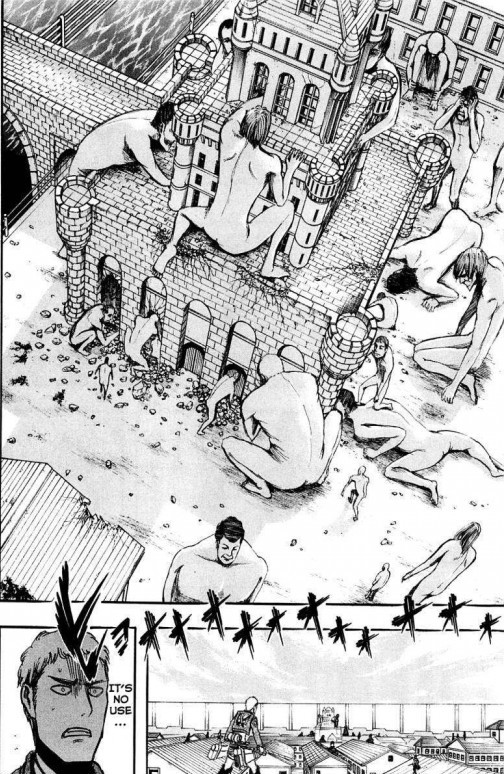
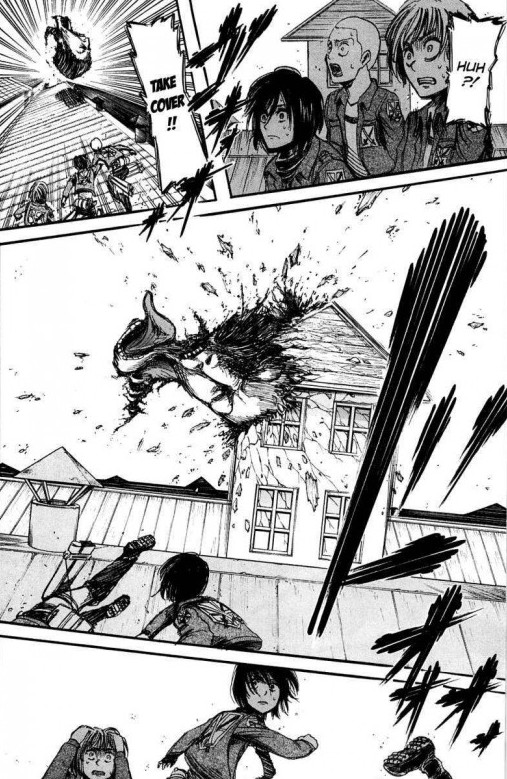
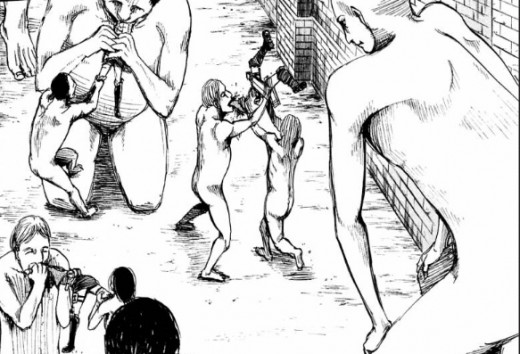
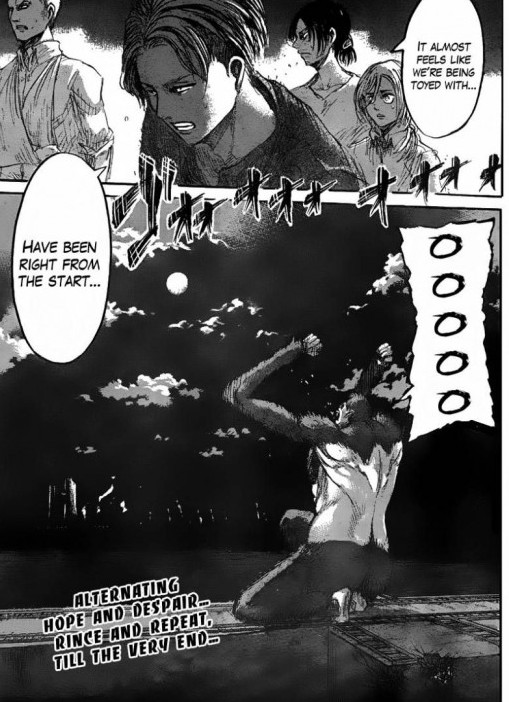
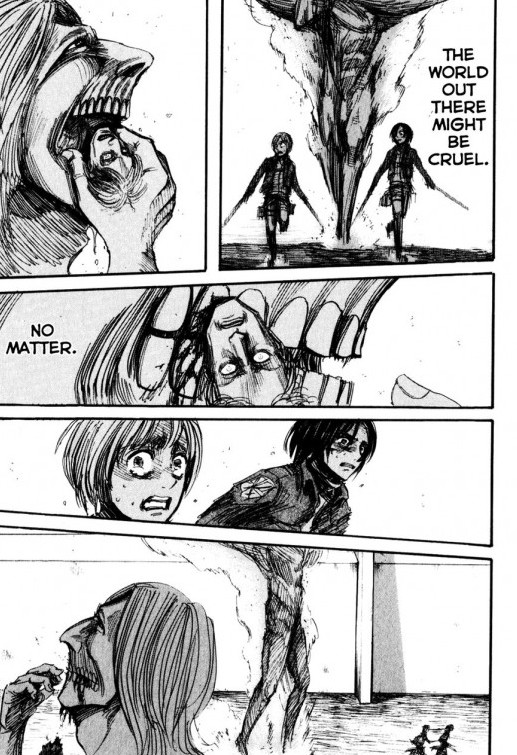
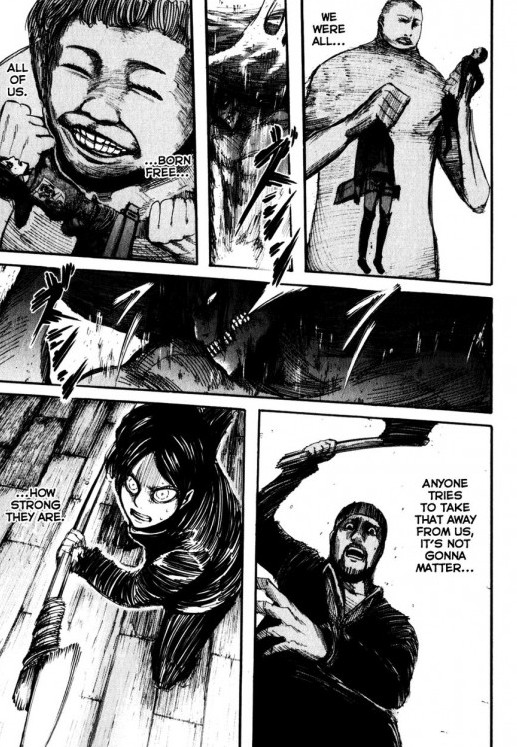
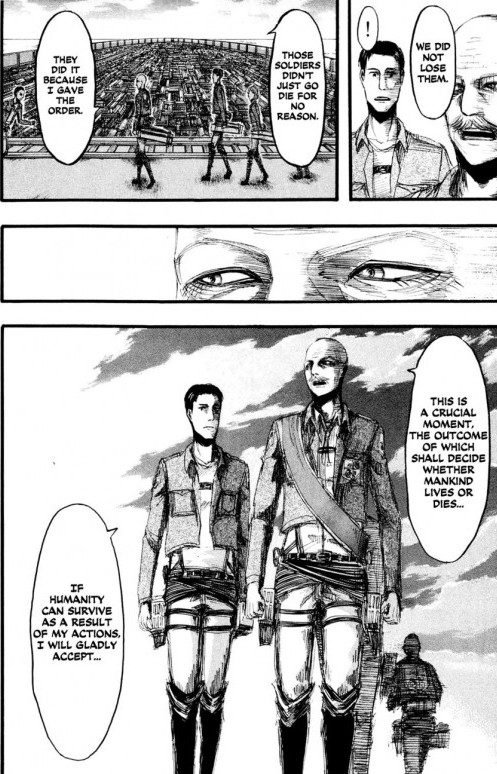
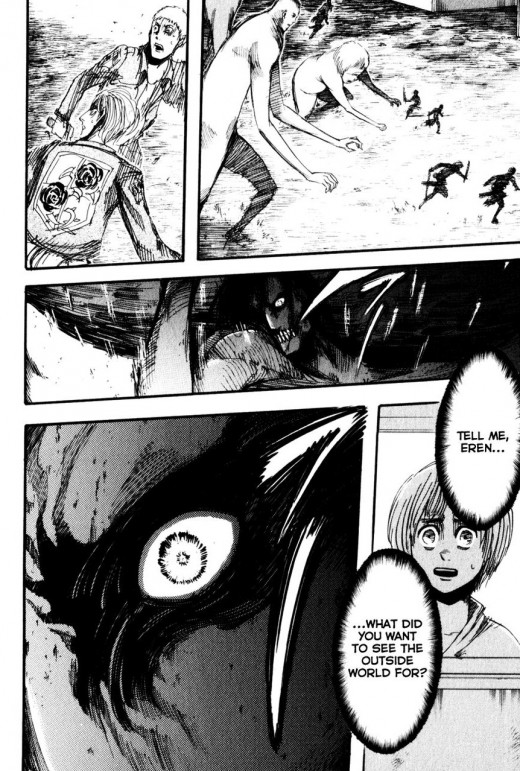
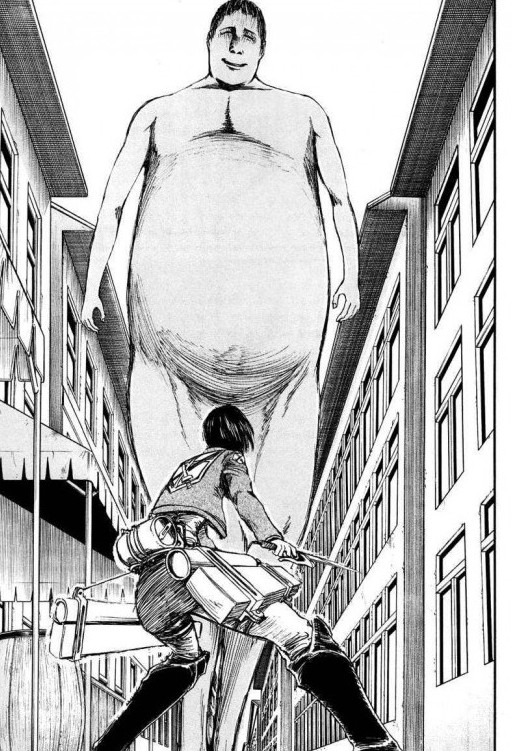
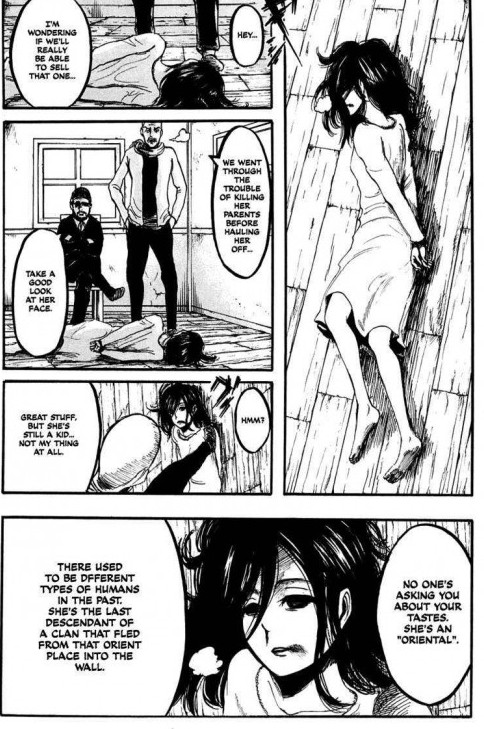
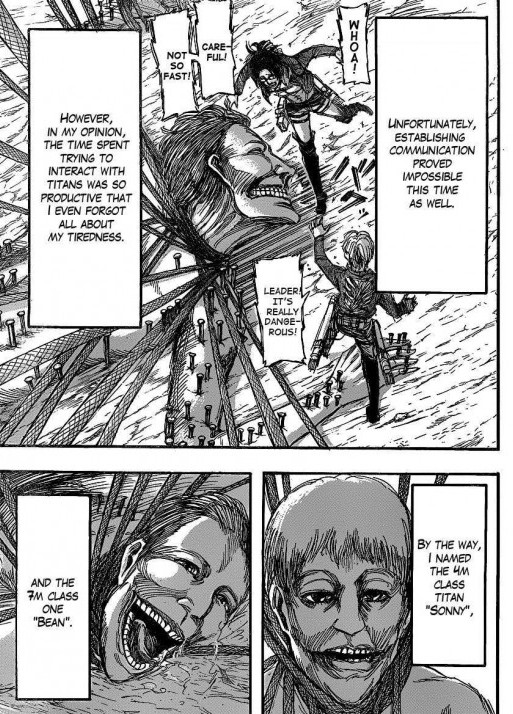
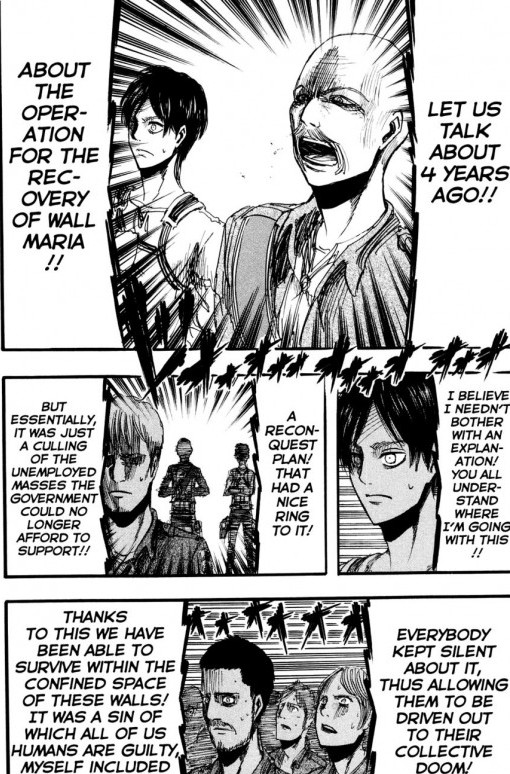
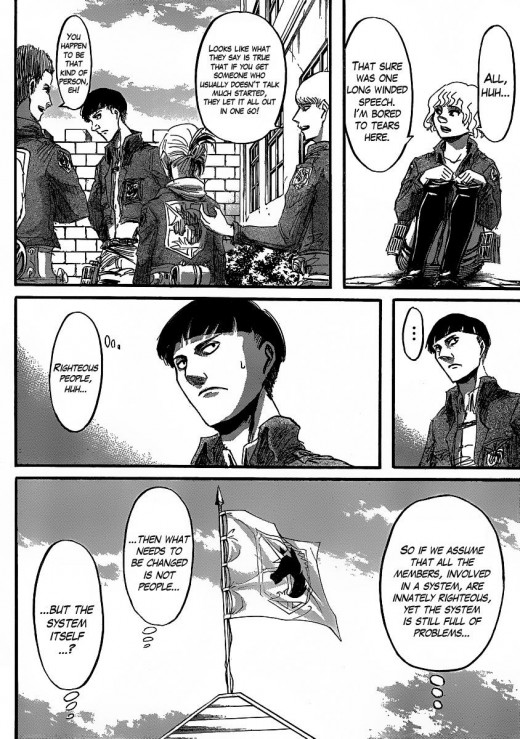
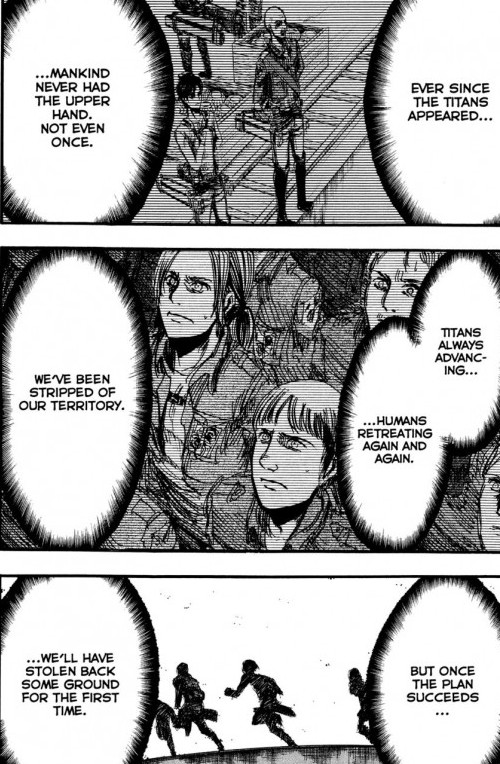
Speaking as a big fan of both Attack on Titan and Pacific Rim: it’s a bit hard to accept pretty much any of what’s written here as credible, given that pirated scanlation images are used and you cite the film Pacific Rim as being from “Benicio” del Toro, to the point where it’s included in both the post tags as well as the text itself. A single Google search would have told you that Pacific Rim is directed by “Guillermo” del Toro.
This is not mere nitpicky pedantry. Attack on Titan did not begin publication until 2009 and wasn’t released in English until June of 2012. The realities of big-budget Hollywood film production are that movies take several years to develop. Pacific Rim was conceived around 2007. If your reaction to seeing a Mexican-born filmmaker that now resides in the United States create a film that points out the futility of the practice of countries advocating building giant walls to keep out foreign aliens is “why, this is just like the brand-new comic book I’m reading!” then I advise you to take a cursory look at the state of American politics regarding immigration policy.
There’s an awful lot of writeups on Pacific Rim with regards to comparisons between it and Neon Genesis Evangelion. Like this one you just wrote, they’re all rather misguided as they’re penned by people seemingly unfamiliar with the body of common ancestry that both Evangelion and Pacific Rim are drawing from: 1960s and 1970s Japanese monster films and giant robot cartoons. I don’t really see much similarity between Pacific Rim and Evangelion aside from perhaps the visual design of the pilot suits, and as such I’m inclined to believe del Toro when he states that he’s never seen Evangelion. And if someone’s never seen Evangelion, which was and remains one of the most popular modern anime series of the last 20 years, it’s a safe bet that they’ve never read or seen Attack on Titan.
So I don’t think you’re “just a cynic” because you don’t seem to care for Pacific Rim as much as you like Attack on Titan. I do however think your approach to evaluating the work is fundamentally misguided, and it has nothing to do with any “don’t think too hard” sort of criticism. It’s the opposite: you should think harder about both.
I’m sure Subdee knew the difference between the del Toro’s and just had a brain moment; I don’t really know the difference, and did the post tags. So, you know, blame me for that at least.
I’m not sure why you can’t accept anything here as credible. There’s a lot of analysis of the manga and the film that doesn’t have to do with the connection between the two of them or with the points you raise. However! Just because you seem to have indulged in a bit of rhetorical excess, I still think the rest of your comments are worth considering. Thanks for stopping by.
IMDB credits two screenwriters on Pacific Rim, Travis Beacham and Guillermo del Toro, I’m going to hazard a guess that a host of producers and uncredited script doctors also contributed to the plot of Pacific Rim. Daryl, you seem confused as to how Hollywood movies are made.
I think it has as much in common with Independence Day than any Japanese monster film. Subdee is right on the money that it’s formulaic Save the Cat type writing. The directors ethnicity seems irrelevant, there isn’t a hint in the film that there’s much more than begrudging recognition of other countries besides the United States. (A better screenwriter would have developed the Russian or Chinese characters more) The one Japanese character was adopted by an American.
I don’t think Subdee said Pacific Rim was influenced by Attack on Titan, but at any rate while movies take several years to develop the initial draft does not necessarily resemble what the final product looks like. Why a comparison would be offensive is beyond me.
Sigh. This may be my fault again. I got from the piece that the film was inspired by the manga, and said that on social media, where Daryl saw it. So, you know — basically all confusion caused by my ignorance (I haven’t seen Pacific Rim or read Attack on Titan.)
I don’t really know what the fuss about Pacific Rim is. It was fun and dumb like a good action movie but so many comics people seem to really really love it. I must not have grown up reading and/or watching enough Japanese monster movie to appreciate it.
I guess Subdee did say there was a “direct connection” which could be interpreted as saying there was “influence” maybe Subdee will clarify.
Yeah; I think she’s in England, so time difference means she’s prob. not following this at the moment…
Apparently the screenwriter on Pacific Rim saw some of Neon Genesis Evangelion, so there could be some influence:
http://www.craveonline.com/film/interviews/531757-exclusive-interview-travis-beacham-on-pacific-rim/2
Daryl Surat: “If your reaction to seeing a Mexican-born filmmaker that now resides in the United States create a film that points out the futility of the practice of countries advocating building giant walls to keep out foreign aliens is “why, this is just like the brand-new comic book I’m reading!”
Well this is interesting. So you’re saying that we should see Pacific Rim as a counterpart to Verhoeven’s version of Starship Troopers? In other words, we’re supposed to feel sort of guilty at enjoying the antics of the Mecha defenders? Because Del Toro sure seems to be advocating the idea that the aliens are evil and should be destroyed.
Subdee: “…at first I thought that this series might be a metaphor for a non-militarized Japan. It is, definitely, very pro-military, very pro-intervention, and very pro-violence. There are other hints of conservative thought, as well, starting from the author’s fundamentally mistrustful view of human nature.”
I don’t think the parallels are even remotely far fetched and they’ve been picked up by some of the Asian newspapers and netizens. I watched 10 minutes of the anime without knowing a thing about the show and picked up on the metaphor straightaway.
The whole thing about comparing themselves to animals and livestock (being hemmed in etc.) definitely gives you a whiff of Lebensraum with all attendant sacrifices of course. On a side note, in Numbers, Joshua and Caleb report back on a land of milk and honey populated by giants as a prelude to the conquest of the Promised Land.
Not that Attack on Titan is especially militaristic cf. other manga but it’s very popular and comes at a time when Shinzo Abe (PM of Japan) is wondering out loud about the definition of “invasion” (or aggression) and wants to modify Article 9 of the Japanese Constitution (that troublesome pacifist one outlawing war etc.). His deputy (Taro Aso) suggested, in all seriousness, that Japan had a thing or two to learn from the Nazis concerning the latter. These guys won the recent election by a landslide.
As for Pacific Rim, the fight scene in the city was pretty cool but the ending a bit underwhelming. Unlike you, I couldn’t manage to dredge up anything resembling a true emotional response to the character deaths. They aroused as much empathy as pieces of cardboard. Having said that, the sheer shallowness of Pacific Rim has one fringe benefit – you don’t have to think too hard about it (though I suppose you could read manifest destiny into it).
Attack on Titan (the anime version) is serious enough that it makes you consider the script and imagery, even if the manga is pretty badly drawn and scripted. I didn’t expect to see Goya’s Saturn Devouring His Son in Attack on Titan but that’s what I got in the anime (less so the manga). In that sense, it’s interesting how so many shows from China are about being oppressed and how many shows/manga from Japan are about the perils and pleasures of the military. Sort of national obsessions?
I can’t believe I got the director’s name wrong. ;_; Thanks for defending me, Noah.
Commenters above have it: I’m not attacking Guillermo for bad writing, I’m attacking the script for reading like it was written by a committee, while also making a tone comparison between the two works. I do think Guillermo del Toro is responsible for the tone of Pacific Rim – he’s talked on the record about wanting to have that “humanity comes together” plot, even though it’s old-fashioned. He’s also talked in interviews, or other people have talked, about developing characters through little details on their costumes or quirks (e.g. the bulldog). Why not develop them through stronger writing?
I know that big budget movies take years to get made; but I also think there is a connection between Attack on Titan and Pacific Rim that’s not coincidental. A lot of it is obsession with similar themes, which is something I talk about in my article; some of it, like the flashback scene with Mako, is suspiciously extremely similar (and the equivalent scene in Attack on Titan occurs early in the manga so it’s entirely possible it could be a lift); finally I think Pacific Rim acknowledges the overlap when it names the robots Jaegers, which is also the name of the main character in Attack on Titan.
So in other words I’m not saying the plot is stolen, but there are definitely a lot of similarities and there’s no reason Pacific Rim couldn’t have taken bits of the manga and thrown the into its Japanese anime-and-monster-movie-inspired stew.
While I don’t think that this is the strongest article I’ve ever written for HU, there is more to it than just “Guillermo del Toro is a thief, he totally ripped off these two anime, Japanese stuff is so much better than Hollywood stuff!!!”
I don’t think he ripped them off, but I do think there are a lot of parallels, probably not all coincidental. I wanted to use those parallels to discuss another series where I believe the themes of Pacific Rim are better developed. Maybe that was a bad idea, after all, there are a lot of anime fans who would have written exactly the article you described.
For the record, I brought up Evangelion because that was how Pacific Rim was described to me. I could have been more clear that section… the point is not to say that they are similar, because they are only superficially similar, but to talk about audience expectations. A common defense of Pacific Rim is that it’s just a giant monster vs robot movie, so it’s silly to expect depth or suspense.
But if you are expecting Evangelion, which is hardly even about the Angels, then it’s not silly at all. And even the old Japanese monster movies weren’t just about monsters destroying cities, anyway. The original Godzilla has real depth, not just thematically but of character: the scene I remember the most clearly from that movie doesn’t involve the guy in the rubber suit at all, but is the scene where the scientist is drink at a party and decides, for seemingly no reason, to stand on the apartment’s 18th floor balcony railing.
If anything, people who talk about how Pacific Rim is just a monster movie are either talking about Godzilla XIX: the endless reboot we could make because the original was so classic, or they are talking about Hollywood blockbuster action movies.
I didn’t think you were saying he ripped them off; inspired by doesn’t mean ripped off….
And I didn’t get that you were saying that Hollywood is always bad. It seemed more like you thought the movie could have been good (as a Hollywood film) and were disappointed because it didn’t manage to be.
Ng Suat Tong’s comment above is awesome and I’ll respond to it after I’ve woken up a bit more. The better article on Attack on Titan might have been the one spent more time discussing the series’ military themes – how’re they are a shift away from the anti-military and pro-environmentalist themes of so many other manga and the connection with the current political climate in Japan.
@Noah yes, exactly. And I think that’s pretty clear in my article. The part about “inspiration” is maybe less clear… I do think there is direct inspiration… of course, that’s something that can’t be proven, so I would have been wise to modify my language a bit in that section of the article. In any case, it’s not the main point of the article.
Subdee: “So in other words I’m not saying the plot is stolen, but there are definitely a lot of similarities and there’s no reason Pacific Rim couldn’t have taken bits of the manga and thrown the into its Japanese anime-and-monster-movie-inspired stew.”
I really do think Daryl’s got it right in terms of common ancestry, rather than one work lifting/getting inspiration from the other. I’m not out to defend Pacific Rim, as I have little stake or interest in either franchise, but both works are so laden with tropes from the classic mecha and kaiju genre works that most similarities between them seem more likely to stem from their shared source material, so to speak. Neither comes across as terribly original. Jäger not only means hunter, but is also the German term for nineteenth century elite infantry (skirmishers or rangers) – an obvious term to use in a genre full of terminology and symbolism referencing Germanic military history. (For other examples of jäger as a term or name, see Pilgrim Jäger, Valkyria Chronicles, Heavy Gear, Legend of Heroes, etc). The use of it in Pacific Rim made me cringe, not because of Attack on Titan but because it is about as cliché as you can get. At least they didn’t call any of the mecha “Paladin.”
And just to be clear, disregarding the less-than-obvious connection made between the two works I do think the essay contains some good analysis of Attack on Titan in its own right!
Thanks for directing us to the “Save the Cat” article; yet another thing I’ve learned from HU.
Suat’s right that the manga — based on what’s here — is badly drawn, but that image of the giants climbing over the building, sticking their hands in, etc. sure is striking. (Although, what’s up with that dude at the middle of the bottom of the panel? I can’t take my eyes off those head-shoulder proportions)
Actually, most of the images here aren’t as bad as other parts of the manga which really contain sloppy drawing. And the titans are the best drawn things in the manga. The anime is actually better than the manga, partly because they use people who can actually draw faces!
There is a clear common ancestor for both Pacific Rim and Attack on Titan and that would be Goya. Del Toro has already stated that he took some inspiration from Goya’s The Colossus and the first episode of the anime clearly has the Saturn reference (making a point to decapitate the mother prior to eating her unlike the manga).
I went out of my way to look for halfway-decent manga panels to post here, yeah.
Actually, though, I kind of like the fact that the art is so uneven. It’s a comic about ideas and monsters, so it’s kind of fitting that the main characters are badly-sketched talking heads, but the monsters and backgrounds are drawn with a lot of care and attention to detail. There’s some really ambitious perspective drawings, too, considering the author can barely draw human figures from the front while they are standing still. The art is just good enough to really get across a sense of horror.
Someone should perform a bit of Liefield revisionism on Hajime Isayama. Clearly it’s the humans who are the monsters, not the titans. That’s the subtext of all this bad cartooning.
Some more articles on Pacific Rim.
http://thiscageisworms.com/2013/07/18/on-the-inhuman-drama-of-pacific-rim/
http://www.filmschoolrejects.com/opinions/how-pacific-rim-got-kaiju-wrong.php
My pop culture connoisseur friend thinks Pacific Rim is a phoney kaiju/giant robot film wannabe that displays a complete ignorance of the actual cinematic techniques of real kaiju and giant robot shows. On the other hand, some prominent Japanese anime/game creators are reported to be inspired by it.
I haven’t watched it; at present I’m only slightly interested in the fact it’s more successful in China than in America.
http://www.hollywoodreporter.com/news/china-box-office-pacific-rim-609698
Funnily enough, the Guardian just published this story about the film’s reception in China
The general reaction to the film that I’ve experienced in Hong Kong has been bemusement and shrugs, but I think the film has done pretty well commercially. One person said something to the effect of “So they remade Independence Day with giant robots, but set it on an American base in Hong Kong? Why?”
I did find the complete lack of Cantonese characters a bit abrasive – the local jäger pilots never speak and generally act as redshirts, and of course the mysterious black marketeer (a potentially interesting character with deep local knowledge) is a westerner. But that’s Hollywood, I suppose. The token foreign characters are a Japanese girl and two Aussies, which is just about as safe a choice as you could possibly get.
I’ll admit that I knew nothing about this comic book series or cartoon until I saw a rather well-done mash-up of it with characters from King of the Hill:
http://www.tumblr.com/tagged/attack-on-hill
@ Jones, one of the Jones boys:
August 28, 2013 at 5:43 pm
“Suat’s right that the manga — based on what’s here — is badly drawn, but that image of the giants climbing over the building, sticking their hands in, etc. sure is striking. (Although, what’s up with that dude at the middle of the bottom of the panel? I can’t take my eyes off those head-shoulder proportions)”
The art in the manga is absolutely godawful, but after reading a few volumes I realized that at least some of the distorted anatomy is deliberate: the very large titans have disproportionately small heads, tiny arms like T Rexes, and big legs with thick ankles. Take it as evidence that the author has put some (superficial) thought into skeletal mechanics, although against the overall quality of figure drawing it’s not at all readily apparent.
I suspect Pacific Rim was well-received because it was a relatively okay film in a period of bad blockbusters. It benefited from poor competition, maybe.
I take the ‘common ancestry’ line on Attack on Titan/Pacific Rim. It’s not impossible that someone involved in Pacific Rim encountered Titan early enough, but it seems very unlikely. It would be possible to write a more solidly-evidenced ‘X is more thoughtful than Y, which was influenced by it’ post about Muv-Luv and Attack on Titan, though, given that Hajime Isayama’s a big Muv-Luv fan.
Pingback: Analisando: Por que 2013 é o ano de Shingeki no Kyojin? | ChuNan! - Chuva de Nanquim
I don’t think the movie was made to have a “deep” storyline or character development. I think the comparison between the anime and this movie is unfair, since this movie is an homage to monster movies like Godzilla. There is nothing “deep” in Godzilla. It is just a monster destroying buildings. And that is what this movie does! It shows you monsters and big ass robots fighting and in a really cool way. Saying a movie is disappointing or bad just because it didn’t meet your expectations is plain stupid!
Godzilla has depth, though. The movie spends a lot of time with the scientists before Godzilla even shows up, and the movie itself is a parable for nuclear destruction.
Maybe the sequels are just monsters destroying things, I haven’t seen them, but first movie is famous for more than just the giant rubber monster.